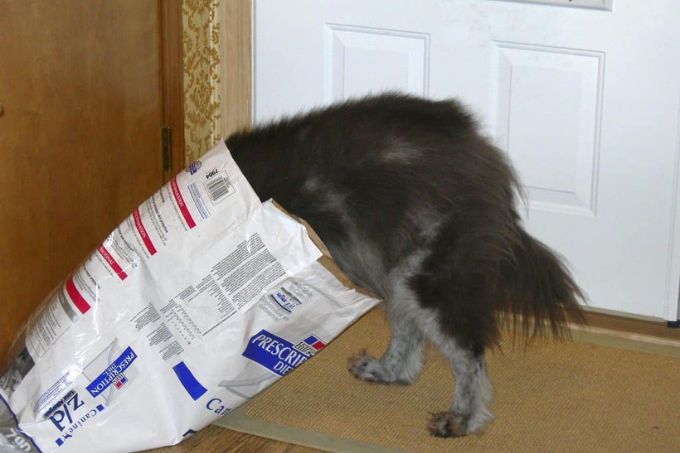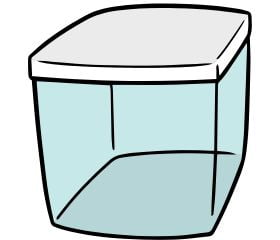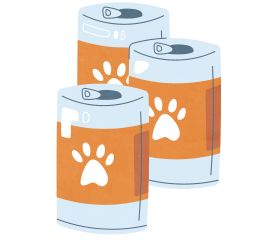This post may contain affiliate links, which means we may receive a commission from purchases made through these links. See our affiliate disclaimer.

Storing dog food properly is a simple yet effective way of prolonging its shelf life.
Here we give you a few broad pointers that will keep your dog’s food fresh, prevent mold & infestations from getting in, plus a few other tips & tricks on how to store dog food.
Why storing dog food properly is important
Just like human food, dog food is perishable and begins to spoil as soon as it’s opened. How quickly the food spoils can depend heavily on how you store it.
With proper storage, dog food can have a longer shelf life, it can stay fresh and nutritious, and can also be safe from invading mold & pests.
It can also be difficult to tell if dog food has gone bad or not, so we try to stick to the practices listed here to prevent spoilage.
Be mindful of expiration dates
Both wet and dry dog food will have an expiration date printed somewhere on the label. Once the food is past its expiration date, it’s best to toss that out — even if it doesn’t smell off.
The expiration date is the time by which nutrients and preservatives in the food have degraded enough that it’s no longer safe to feed to your dog. This is determined by the manufacturer based on their precise recipes, and it’s best to heed their recommendation on this matter.
Any food that looks or smells spoiled, despite not being past its expiration date, should likewise be tossed out.
Buy smaller amounts of dog food
We recommend buying smaller amounts of dog food more frequently, ideally a new bag every 4-6 weeks.
Once dog food is opened, the expiration date printed on the bag no longer applies. Any opened bag of dry dog food should be consumed within 4-6 weeks. Wet dog food should be refrigerated once opened, and consumed within 5-7 days.
A tip for storing food bought in bulk
We get it, dog food is expensive, and buying it in bulk can save you mucho bucks.
For those who choose to buy larger bags of dog food, we have an additional tip: leave most of the dog food stored in its original bag, and scoop a week’s supply into a smaller container for daily use. This is so you won’t have to keep opening the bigger bag of dog food, and exposing it repeatedly to air & moisture.
Use airtight containers

Dog food that is exposed to air will grow bacteria and spoil more quickly. Storing it in airtight containers minimizes this risk, and is also the most effective way of prolonging shelf life.
For dry dog food
We recommend keeping dry dog food in the bag they came in, then placing those bags into airtight containers. Having the original packaging (and the lot number) may come in handy in case of product recalls.
We don’t recommend pouring the bag of dry dog food directly into the container. The kibble leaves an oily residue behind, which can turn rancid over time and affect the quality & taste of food. Moreover, kibble with sharp edges can damage a plastic container’s surface and become a breeding ground for bacteria.
If you prefer not to buy a container, you can roll the bag down to push all the air out, and use a strong clip to keep it sealed.
For wet dog food
We recommend using can covers for opened cans of dog food, then storing these cans in the refrigerator for up to 7 days. The FDA recommends storing wet dog food at 40° F (4.4° C) or below.

The key here is not to leave the open can exposed to room temperature air for any prolonged period. This type of food can spoil within hours if left on the counter, for example.
Storing the can in the freezer will keep the food for longer. Use freezer-safe baggies or containers for this. To consume, thaw the food in the fridge for 8 hours before serving.
Store food in a cool, dry place
Exposure to moisture will allow mold to grow. And exposure to heat is the most overlooked aspect of food storage practices among fur parents, according to this study.
Storing your dog’s food in a closet or pantry is the best practice, just as you would do with human food. Make sure this space is not easily accessible to your dogs or any kids in the house. Keeping the containers above ground (not directly on the floor) will make it harder for ants or rodents to get in, even if it’s just an inch or 2 elevated.
Avoid the garage, where it can get hot and humid, or any other open spaces. If you live in warmer climate, storing dry dog food in the fridge is also an option. The FDA recommends a space no hotter than 80° F (26.6° C) for dry dog food.
Other tips on how to store dog food
First in, first out
Make sure to use up all the dog food in your container before refilling it with newer dog food. Otherwise the newer food will be on top and gets consumed first, while the older food will remain at the bottom and might spoil, contaminating the rest of the food.
First in, first out is common practice in the food industry to prevent food spoilage & wastage.
Wash storage containers between each refill
The containers used to store your dog food should be washed regularly. We recommend washing them prior to each refill.
This is especially important if the dog food is in direct contact with the container. Empty out the crumbs left behind and wash with soap and warm water.
Use a dedicated scoop
We recommend using a dedicated scoop for your dog’s food. Using one minimizes the chances of contaminants getting in the dog food.
Leave the scoop in with the dog food so it’s there whenever you need it, and give it a wash whenever the container gets a wash.
Wash dog bowls before each use
Lastly, your dogs bowls should get a wash before each use. We understand this can be tedious, but there’s no shortcut for this hygienic practice.
Leftover food and liquids, scum left behind after they lick their bowls clean — all of these things stick to the bowl and can affect the smell & taste of your dog’s next meal. Worse, bacteria can grow in this medium and make your dog sick. Luckily a quick soap and rinse takes care of all these problems.
Great! Now that you know how to store dog food, why not check out some of our other dog feeding guides?

